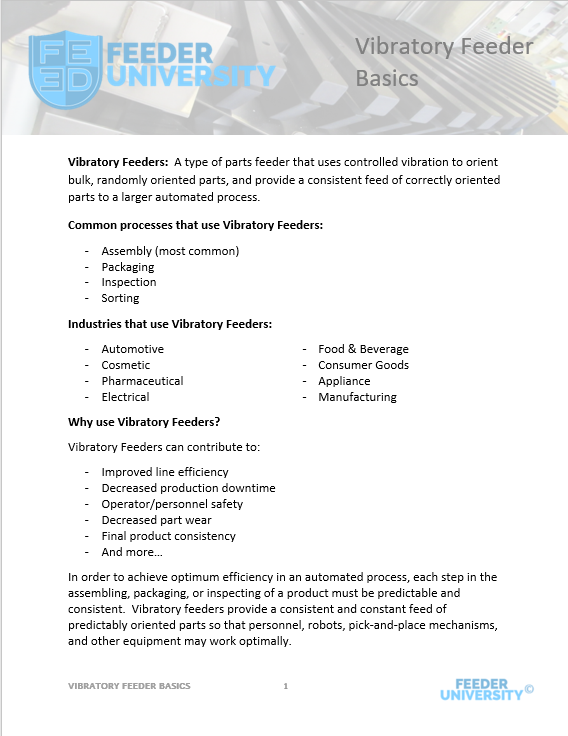This video showcases what a vibratory feeder bowl is and how it works. Using controlled vibration, parts can be prepared for the next phase in the process.
For every job, it seems, there is an ideal tool. Vibratory feeders describe a specific, but diverse category of process automation equipment that has been found to be ideal in many automated assembly, packaging, and inspection processes. These machines are durable, most of which are made from stainless steel and other high-wear materials and contain very few moving parts, also making them extremely reliable if build and implemented correctly. From heav and abrasive nuts and bolts, to delicate ceramic discs, vibratory feeders can be adapted to an incredibly wide range of applications.
Vibratory feeders are most common in the automotive industry for their wide ranges of sub-assemblies, each with their own dedicated process requiring a variety of parts and pieces to be ready for robots, mechanisms, and personnel to assemble them together. Typical cycle times (output rates) for vibratory feeders range up to 250 parts per minute, although there is not set limit.
Customizability is one of the strong suits of a vibratory feeder and with sizes ranging from a few inches in diameter to upwards of 42 inches accross, there are few mass-produced products whose assembled components fall outside of the range of their capability.
 WHITEPAPER: Vibratory Feeder Basics
WHITEPAPER: Vibratory Feeder BasicsVibratory Feeders: A type of parts feeder that uses controlled vibration to orient bulk, randomly oriented parts, and provide a consistent feed of correctly oriented parts to a larger automated process.
In most settings, vibratory feeders are accompanied by one or more complimentary pieces of equipment, all considered to be a part of the feeding systems. The most common kinds of equipment integrated directly with a vibratory feeder are storage hoppers/elevatores, vibratory inlines, and isolation/relocation mechanisms.
Storage Hopper/Elevator: Provides extra storage for bulk, unoriented parts before they enter the vibratory feeder itself and is used to extend the run-time of a vibratory feeder system between operators adding parts to the system.
Vibratory Inlines: A linear track that also uses controlled vibration and tooling features to store a queue of already oriented parts after the vibratory feeder orients them. These devises act as a buffer to the feeder bowl and allows the following steps in the process to work fluidly while the vibratory feeder continues to output correctly oriented parts.
Isolation/Relocation Mechanisms: Added after the inline, these mechanisms can isolate or relocate single or multiple parts so that the subsequent step in the assembly process can pick one or more parts without damaging or interfering with the part waiting to be picked next.
If you think you are in need of a parts feeder and are not sure whether or not your application will work, consult with the experts at Hoosier Feeder Company
Over time, vibratory feeder springs harden and cause the machine to operate sub-optimally. A quick diagnosis and fix can get the process up and running again.
The location of the load area of a centrifugal feeder can have a large impact on the overall layout of a packaging line. Plan ahead and save time and money when installing the finished feeder.